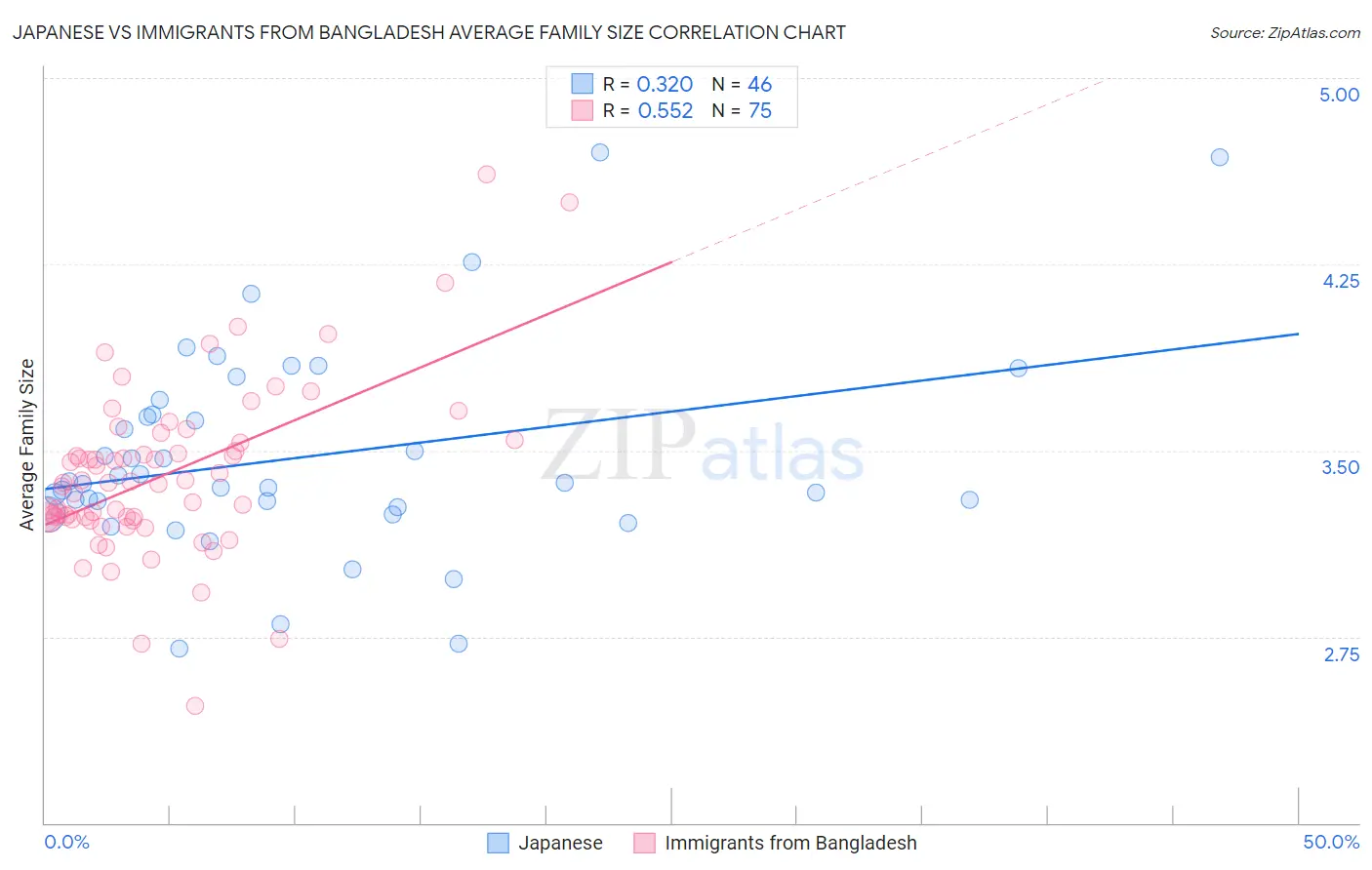Japanese vs Immigrants from Bangladesh Average Family Size
COMPARE
Japanese
Immigrants from Bangladesh
Average Family Size
Average Family Size Comparison
Japanese
Immigrants from Bangladesh
3.35
AVERAGE FAMILY SIZE
100.0/ 100
METRIC RATING
59th/ 347
METRIC RANK
3.36
AVERAGE FAMILY SIZE
100.0/ 100
METRIC RATING
50th/ 347
METRIC RANK
Japanese vs Immigrants from Bangladesh Average Family Size Correlation Chart
The statistical analysis conducted on geographies consisting of 249,073,483 people shows a mild positive correlation between the proportion of Japanese and average family size in the United States with a correlation coefficient (R) of 0.320 and weighted average of 3.35. Similarly, the statistical analysis conducted on geographies consisting of 203,581,680 people shows a substantial positive correlation between the proportion of Immigrants from Bangladesh and average family size in the United States with a correlation coefficient (R) of 0.552 and weighted average of 3.36, a difference of 0.44%.

Average Family Size Correlation Summary
| Measurement | Japanese | Immigrants from Bangladesh |
| Minimum | 2.70 | 2.47 |
| Maximum | 4.70 | 4.61 |
| Range | 2.00 | 2.14 |
| Mean | 3.47 | 3.40 |
| Median | 3.37 | 3.37 |
| Interquartile 25% (IQ1) | 3.27 | 3.22 |
| Interquartile 75% (IQ3) | 3.65 | 3.53 |
| Interquartile Range (IQR) | 0.38 | 0.31 |
| Standard Deviation (Sample) | 0.42 | 0.34 |
| Standard Deviation (Population) | 0.41 | 0.34 |
Demographics Similar to Japanese and Immigrants from Bangladesh by Average Family Size
In terms of average family size, the demographic groups most similar to Japanese are Immigrants from Armenia (3.35, a difference of 0.020%), Central American Indian (3.35, a difference of 0.050%), Honduran (3.35, a difference of 0.090%), Sri Lankan (3.35, a difference of 0.10%), and Immigrants from Dominican Republic (3.35, a difference of 0.15%). Similarly, the demographic groups most similar to Immigrants from Bangladesh are Nicaraguan (3.36, a difference of 0.070%), Fijian (3.36, a difference of 0.13%), Bangladeshi (3.37, a difference of 0.14%), Korean (3.36, a difference of 0.16%), and Immigrants from South Eastern Asia (3.36, a difference of 0.18%).
| Demographics | Rating | Rank | Average Family Size |
| Alaska Natives | 100.0 /100 | #44 | Exceptional 3.37 |
| Shoshone | 100.0 /100 | #45 | Exceptional 3.37 |
| Haitians | 100.0 /100 | #46 | Exceptional 3.37 |
| Vietnamese | 100.0 /100 | #47 | Exceptional 3.37 |
| Immigrants | Nicaragua | 100.0 /100 | #48 | Exceptional 3.37 |
| Bangladeshis | 100.0 /100 | #49 | Exceptional 3.37 |
| Immigrants | Bangladesh | 100.0 /100 | #50 | Exceptional 3.36 |
| Nicaraguans | 100.0 /100 | #51 | Exceptional 3.36 |
| Fijians | 100.0 /100 | #52 | Exceptional 3.36 |
| Koreans | 100.0 /100 | #53 | Exceptional 3.36 |
| Immigrants | South Eastern Asia | 100.0 /100 | #54 | Exceptional 3.36 |
| Immigrants | Honduras | 100.0 /100 | #55 | Exceptional 3.36 |
| Immigrants | Dominican Republic | 100.0 /100 | #56 | Exceptional 3.35 |
| Sri Lankans | 100.0 /100 | #57 | Exceptional 3.35 |
| Hondurans | 100.0 /100 | #58 | Exceptional 3.35 |
| Japanese | 100.0 /100 | #59 | Exceptional 3.35 |
| Immigrants | Armenia | 100.0 /100 | #60 | Exceptional 3.35 |
| Central American Indians | 100.0 /100 | #61 | Exceptional 3.35 |
| Immigrants | Grenada | 100.0 /100 | #62 | Exceptional 3.34 |
| Chinese | 100.0 /100 | #63 | Exceptional 3.34 |
| Dominicans | 99.9 /100 | #64 | Exceptional 3.34 |